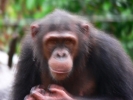 Research by Washington University in St. Louis anthropologist Crickette Sanz, PhD, and colleague David Morgan, PhD, has spurred the Republic of Congo to enlarge its Nouabal‚-Ndoki National Park boundaries to include the Goualougo Triangle. The Goualougo Triangle is a remote, pristine forest that is home to at least 14 communities of 'naive'— chimpanzees with little exposure to humans.
Research by Washington University in St. Louis anthropologist Crickette Sanz, PhD, and colleague David Morgan, PhD, has spurred the Republic of Congo to enlarge its Nouabal‚-Ndoki National Park boundaries to include the Goualougo Triangle. The Goualougo Triangle is a remote, pristine forest that is home to at least 14 communities of 'naive'— chimpanzees with little exposure to humans.
The expansion, announced in January, increases the size of the protected area by 144 square miles to encompass 1,636 square miles of the northern Republic of Congo. The park is managed by the Republic of Congo's Ministere du Developpement Durable, de l'Economie Forestiere et de l'“Environnement with support from the Wildlife Conservation Society (WCS).
This expansion is a great victory for scientists and conservationists because the Goualougo area and its animal populations are unique throughout the globe, and it holds great promise for further research in many different fields, including anthropology Sanz says.
The Goualougo Triangle, a dense lowland forest, is home to approximately 600 chimpanzees, including the chimpanzee communities studied by Sanz, assistant professor of anthropology in Arts & Sciences at WUSTL, and her husband, Morgan, research associate in anthropology at WUSTL and conservation fellow at the Lincoln Park Zoo in Chicago.
Many of the Goualougo Triangle chimpanzees are na_ve meaning they've had little exposure to humans and will investigate humans they see, rather than run from them.
Studies by Sanz and Morgan have shown that this population of chimpanzees uses a number of specialized tool sets to extract insects from nests. For example, a stout wooden tool is used to make an entry point into a termite nest, and then a flexible probe is used to extract the termite snacks. Their discoveries were the first to show the customary use of complex and improved tool designs by wild apes.
This and other discoveries by Sanz and Morgan directly influenced the government of the Republic of Congo to increase the size of the national park to include the Goualougo Triangle and its populations of chimpanzees, gorillas, elephants, leopards and more.


